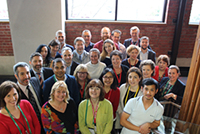The Australian government’s commitment to increasing organ and tissue donation for transplantation is on its way to being realised — and the Blood Service is set to play a pivotal role.
On Friday 2 September 2016 the Blood Service hosted the launch of the discovery phase of the Australian Organ Matching System (AOMS) project — a joint initiative between the Organ Tissue Authority (OTA) and the Blood Service — at our Melbourne Processing Centre.
AOMS will replace the current National Organ Matching System (NOMS) and is a new platform to enable the transplantation sector to determine the most appropriate match of solid organs for transplant patients. It will support all solid organ transplant programs including living donor kidney transplants, Australian Kidney Exchange Program and the deceased organ donor program. Expected to be completed by 2018, it’s one part of the Australian Government’s 2015 pledge to accelerate growth in organ and tissue donation for transplantation.
DonateLife Victoria, which is affiliated with the Blood Service, is also focused on delivering other parts of the plan to improve Australia’s donation rates. This includes continuing community engagement, promoting registration on the Australian Organ Donor Register and implementing best practice in all aspects of organ and tissue donation.
Kate Wilson, Senior Manager of the Blood Service’s Information Communications Technology Enterprise Systems, is excited about what AOMS will bring.
“The Blood Service will play a role in ultimately ensuring the optimal matching of donor organs to transplant recipients.
“NOMS has been supporting the transplantation sector for the last 16 years, which is an amazing achievement. But technology over that time has substantially shifted and the current platform needs to be replaced to support changes in the transplantation sector, both now and into the future.”
Funded by OTA, and managed by the Blood Service, the system will be built by one of our technology partners, Datacom. It will be used by five transplantation and immunogenetics laboratories, three of which are at the Blood Service, as well as by clinicians around the country.
“Transplantation laboratories nationally are completely dependent on NOMS to manage all patient and donor laboratory testing and previous transplant results for all types of solid organ transplantation,” said Rhonda Holdsworth, the Blood Service’s National Manager of Transplantation Services.
“Getting the best outcomes for patients is dependent on having the best software for matching and allocation for solid organ transplantation and it’s great to know we’ve taken the first step in the right direction!”
Photo: The discovery phase of the Australian Organ Matching System was launched at the Blood Service’s Melbourne Processing Centre.

